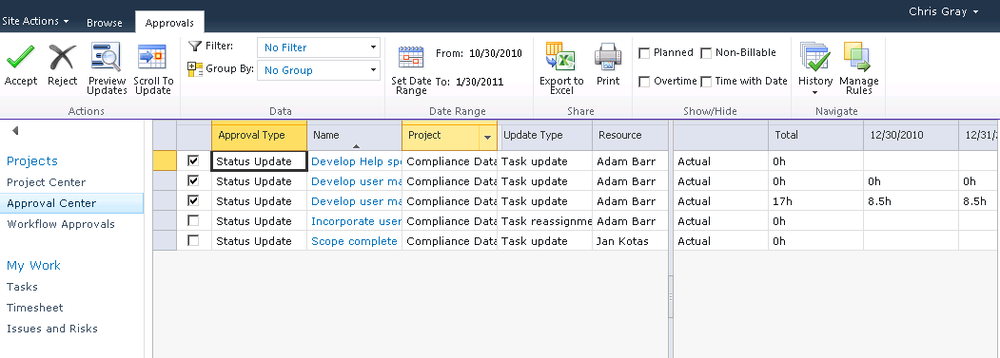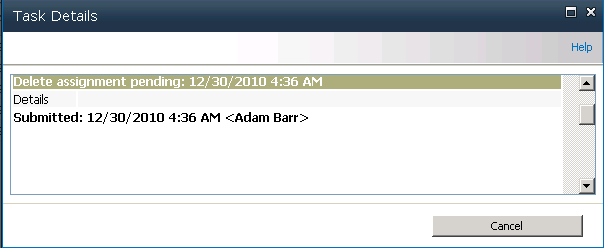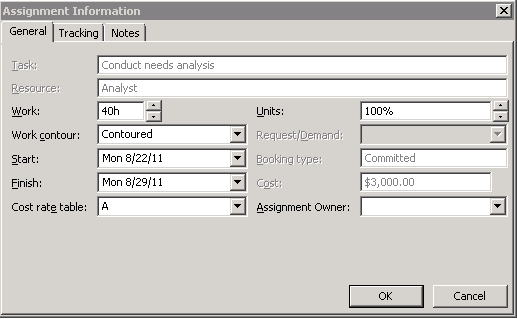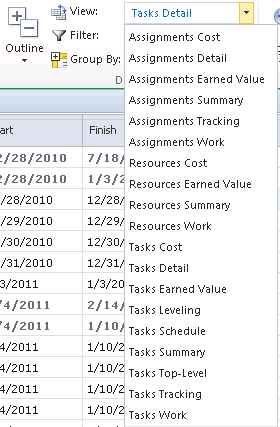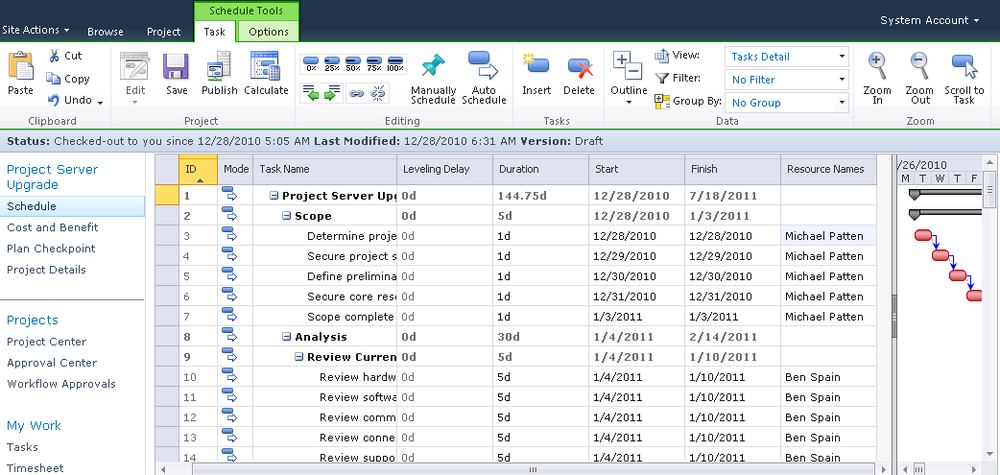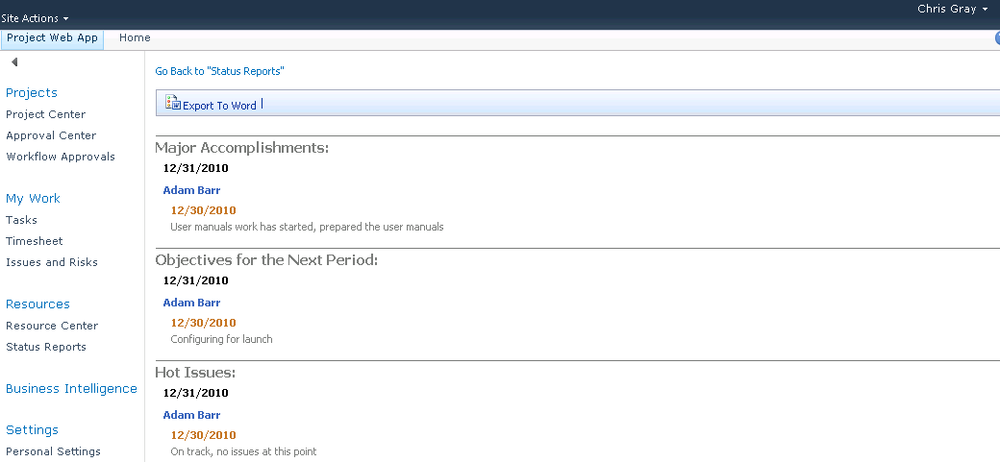After you set up your enterprise project team, you have powerful methods of project collaboration and communication at your fingertips. Using Project Professional and Project Web App, you can assign tasks to resources, receive progress updates, and request narrative status reports—all electronically via publication of information to your project server.
This collaboration process automates the gathering and entry of actuals so that you don’t have to enter actuals on assignments yourself. Your project server administrator or portfolio manager sets up your resources’ task progress pages in Project Web App so that the resources can enter and submit their actuals on a periodic basis. You can then review these actuals and accept them for incorporation into the project plan.
To keep a close eye on time usage and project availability, you can also track nonproject tasks and time through the use of timesheets and administrative time such as nonproject meetings, training, or nonworking time requested by resources.
Because Project Server is built on SharePoint Server, you can also control project-related documents, track project issues, and manage project risks.
When collaborating with your resources on their project assignments, three basic activities are at work:
You publish project information, thereby making project and assignment information available on the project server for resources and other Project Web App users.
You request information such as task updates, timesheets, and status reports from resources.
You review and accept information such as task updates, timesheets, and status reports from resources and then incorporate that information into the project plan.
Before you start doing any of these, it’s a great idea to set up options that govern the details of how these activities are done.
Your enterprise project plan is built, resources are added to the project, and those resources are assigned to tasks. Furthermore, your options for team collaboration using Project Web App are set up. You are ready to start moving forward on your project.
Although all the information about your project is published on the project server, the four primary types of information you are exchanging with your resources are:
Task assignments and progress updates on those assignments
Narrative status reports about assigned tasks
Issues, risks, and project document updates
Nonproject information such as timesheets and administrative time
Merely saving a project to the project server does not make it available for other users to see and work with. You must explicitly give the Publish command in Project Professional or the Publish command on the Project tab in Project Web App for the project information to be published to the project server and become usable to your resources and other users of the project server with the right permissions.
When you publish your project, changes you have made since the last time you published are made public on the project server. Although you can explicitly exclude certain tasks from being published, typically all changes in your project are published at the same time. This includes new assignments, changed assignments, and any other information changed throughout the entire project.
Note
For more information about publishing your project and excluding certain tasks from being published, see Managing Your Files on the Project Server.
When you publish a project, assignments from the project appear on the Project Web App Tasks page for the assigned resources. By default, the assigned resources see an alert on their Home pages indicating that new tasks have been assigned to them. On their My Work pages, the new assignments are marked with the New! icon. A resource can view details about the assignment, including the start and finish date, the amount of scheduled work, other resources assigned, predecessor and successor tasks, and notes.
If you publish a project that includes changed assignments, those assignments are marked with the Assignment Updated icon in the assigned resources’ Tasks page. Resources can also see details of the entire project by clicking its name in the Project Center. This is helpful for resources who want to see the overall context of their assignments.
Note
For details about how resources and resource managers work with assigned tasks, see Chapter 25.
While your resources are working on their assignments, you periodically need progress updates of actual work on assignments. You can request progress updates and then accept and incorporate those updates into your project plan.
As soon as you publish a project and task lists on the project server, team members to whom you assigned tasks are notified of their assignments on their Tasks page and can start executing the work.
It’s best for you and your project team to agree on when task updates should be submitted—for example, every Monday morning or every other Wednesday by noon. You might also want them to send you a task update whenever a task is completed, whenever a major milestone or deliverable has been fulfilled, or whenever there is a significant change or accomplishment.
Task updates consist of some measure of how much work has been done per day or per week on assigned tasks. This measure can be one or more of the following:
Percent of work complete
Actual work done and work remaining
Hours of work done per period
It is the responsibility of the project server administrator or portfolio manager to set up the assignment tracking method, the layout of the resources’ Tasks page to accommodate the preferred tracking method, and the frequency of task update reporting. This is done on the Task Settings And Display page, as described in Setting Timesheet Defaults and Update Restrictions.
Just as you publish information for resources to see on the project server, resources submit information to keep you informed. Whenever they change a task assignment in some way—whether to update their progress, reassign it to someone else, or reject it—they can save it or they can submit it. When they submit it, the information is essentially published, and you are notified. Upon submitting the information, they can enter a comment about the transaction.
When your resources submit updates about their assignments, by default a reminder appears on your Project Web App Home page—for example, “You have 3 task updates from resources pending your approval.” Click the link in that reminder to go to the Approval Center in Project Web App. Or, on the Quick Launch, under Projects, click Approval Center.
Update notifications also appear in Project Professional. On the File tab, click Info. In the Approvals section, see whether any updates have been submitted. If they have, click Check For Updates. The Approval Center in Project Web App opens in a new browser window.
In the Approval Center, you can review the information that your project team members submit. You can also decide whether to accept the information and incorporate it into your project plan or take some other action. (See Figure 24-30.)
Figure 24-30. The Approval Center shows any assignment information that has been submitted by a resource assigned to tasks in one of your projects.
Resources typically submit three types of task update information to the project server for you to review, accept, and incorporate, as appropriate:
Rejected assignments. When you publish new assignments to the project server, resources see their assignments on their Tasks pages. If necessary, resources can delete, or reject, an assignment. Project Web App prompts resources to type a comment when they submit assignments, generally to explain why they have rejected the assignment. You see any deleted assignments, along with the comment, listed in the Approval Center. (See Figure 24-31.)
New self-assigned or reassigned tasks. Resources can create new tasks, assign themselves to them, and submit them to the project server for inclusion in the project plan, if you approve. This is particularly helpful when you are relying on your resources to fill in the details of tasks that are needed for their areas of expertise. If your resources are members of a team assignment pool, they can assign themselves to a team task. If you allow it, your resources can reassign tasks to other resources on your team.
When resources assign themselves to newly created tasks, assign themselves to team tasks, or reassign tasks to other resources, you are notified in the Approvals Center. This way you always know of any new tasks and the specific resources working on those tasks.
Assignment progress updates. When you send a request for progress information, resources respond by updating their assignment-tracking information according to the tracking method set up by the project server administrator. They might update percentage complete on their current assignments, enter total work and remaining work hours on assignments, or enter the number of hours per day or per week they’ve spent on each assignment. Such updates are one of the primary reasons for using Project Web App. They keep your project tracking up to date, and you always know the current status of tasks without having to collect and enter the information manually. Review the task update and any comments from the Approvals Center.
Once you have reviewed the task update information submitted by your resources, you can decide whether to incorporate the information into the project plan or return it to the resource who sent the update.
To accept a task update, follow these steps:
On the Approval Center, select the check box next to the name of the assignment(s) you want to accept and incorporate into your project plan.
If you’re not sure whether you want to accept or reject an update, select the assignment in question, and then on the Approvals tab, in the Actions group, click Preview Updates. A separate Approval Preview window appears with a Gantt chart showing how the schedule will look if you accept the update. Using this window, you can see the updated schedule in a web browser before you commit to the changes the update would cause.
On the Approvals tab, in the Actions group, click Accept or Reject.
In the dialog box that appears, you have another chance to view an approval preview. You can also enter a transaction comment that becomes part of the assignment for the resource to see. Click Accept or Reject.
If you click Accept, the information is submitted to the project server, and your project plan is updated accordingly. If the update was an assignment rejection, the resource is removed from the task. If the update was a reassigned task, the new resource is shown as assigned to the task in the project plan. If it was a progress update, the tracking information is incorporated into the project plan. Accepted task updates are removed from the Task Updates table.
If you click Reject, your project plan is unchanged, and the task update is removed from your Approval Center page. The task is updated on the Tasks page of the resource with a reject icon.
After you accept or reject the task updates, publish them to the project server. To do this, on the Approvals tab, in the Navigate group, click History, and then click Status Updates.
The Status Updates page appears, as shown in Figure 24-32.
Select the check boxes for all the updates listed. On the Status Updates tab, in the Actions group, click Publish.
It’s great to get task updates specifying the percentage complete or the number of hours worked each day on a task. However, often you want more detail about task progress. That’s where narrative status reports come in.
You can design a status report for resources to complete and submit periodically. You set up how often the status report should be submitted. You also set up the topics that the resources should report on. At the designated time periods, your resources write their status reports and submit them to the project server. When the resources’ reports are in, the project server automatically compiles them into a full team status report.
You need to request the status report only when you first set it up. Resources see automated reminders on their Project Web App Home page when a status report is coming due.
To set up the format and request that your resources submit regular text-based status updates, follow these steps:
On the Quick Launch, under Resources, click Status Reports.
In the Requests section, in the toolbar, click New, and then click New Request.
The Status Report Request page appears as shown in Figure 24-33.
Work through the page to specify the design and frequency of your status report.
In the Frequency section, specify how often and when the status report is to be submitted.
In the Resources area, select the resources who are to receive this status report request and who will be responsible for submitting the status report.
In the Sections area, specify the headings for the status report. Your resources will report information using these headings.
To add a new heading, click Insert Section in the toolbar above the table. A new row appears in the table. Click in the row, and then type the heading you want.
To remove a heading, click it, and then click Delete Section.
When you have finished designing the status report, click Send.
The status report request, details, and schedule are sent to the resources you selected. They will see reminders on their Project Web App Home page about status reports coming due. They will also see the name of the status report listed on their Status Reports page, which they can see on the Quick Launch under Resources.
Note
For more information about how resources work with their status reports, see Submitting Text-Based Status Reports.
Project Web App automatically merges the status reports from all resources for a given time period. To review the combined status reports that have been submitted, follow these steps:
In Project Web App, on the Quick Launch, under Resources, click Status Reports.
Under Requests, click the name of the status report whose responses you want to review.
The View Responses page appears.
To specify the time period of status reports you want to see, set the dates in the View Status Reports From boxes, and then click Apply.
Under Group Merged Reports By, specify whether you want the merged report to be grouped by resource name or response date.
In the table, click the icon for the status report.
The merged status report appears. The responses from each resource are grouped under the section headings you identified, as shown in Figure 24-34.
If you want to include the status report in a Microsoft Word document for printing or for inclusion in a project status report, in the toolbar above the status report, click Export To Word.
Timesheets are used for tracking nonproject working time and time off in conjunction with time spent on projects. With timesheets, an organization can essentially account for every hour of every resource’s day, even time that’s spent in meetings, in training, on different projects, or on time off.
Such detailed tracking is important in organizations that have specific time-reporting requirements. For example, certain organizations need visibility into certain time categories—for example, billable and nonbillable time, scheduled and actual time, or overtime. Default time categories are provided with the timesheet in Project Web App, but your project server administrator can set up custom time categories as appropriate.
The timesheet is especially useful when you need to integrate information about resource time with an accounting or general ledger system, particularly for client-billing purposes.
If your organization does not need such tight time tracking, you can simply ignore the timesheet feature and use just the Tasks page to keep the project plan up to date. In fact, the project server administrator could set up Project Web App in such a way as to remove the timesheet pages and links.
New in Project Server 2010 is the timesheet single-entry mode, which unifies the data entered in the Timesheet and Tasks pages. The project server administrator can establish whether timesheet and task progress information should be unified in single-entry mode or kept separate.
However your organization decides to use timesheets, here are some key points to understand:
Your project server administrator or portfolio manager sets up the timesheet format. This includes the fiscal year and reporting periods, accounting classifications, billing categories, and any rules and restrictions for how timesheets are updated.
Note
For information about what’s involved in setting up the timesheet format, see Setting Up Team Member Work Pages.
Timesheets can be updated independently of the task progress page, or they can be set up to be one and the same in single-entry mode.
Resources can identify and report administrative time, which is used to account for nonproject working time such as meetings and classes. Administrative time can also be used to account for nonworking time, such as vacations and personal time off.
If your organization uses timesheets, all resources using Project Web App are associated with a timesheet manager. This could be the resource’s supervisor, the resource manager, or the project manager. The timesheet manager is responsible for reviewing and approving the resource’s periodic timesheets and any administrative time that requires approval. The project server administrator or another user with permissions to edit resource information identifies each resource’s timesheet manager.
Similar to how they update tasks from the Tasks page, resources submit timesheets to their designated timesheet managers on a periodic basis. If you are serving as a timesheet manager, you will receive timesheets for review and approval. Timesheets can be set up for automatic approval.
To review and approve timesheets, follow these steps:
On the Quick Launch, under Projects, click Approval Center.
On the Approvals tab, in the Data group, click in the Filter box, and then click Timesheet or Timesheet Lines.
The timesheet might contain project work, administrative work, and so on.
To approve a timesheet, select the check box next to the timesheet, and then click Approve.
To reject the timesheet items, select the check box next to the timesheet items, and then click Reject.
Note
For information about how resources work with their timesheets, or if you need to submit timesheets yourself, see Logging Time by Using Timesheets.
No matter how dedicated and conscientious, no one can spend every minute of the workday or workweek devoted to project assignments. They need to take some time for nonproject and nonbillable tasks such as handling e-mail, attending staff meetings, and participating in training workshops.
In addition, some nonworking time is bound to happen during the course of a project, such as sick time, vacation time, and holidays.
Through the use of timesheets in Project Web App, administrative time can be used to account for and even track nonproject time. Resources can assign themselves to an administrative time category in the timesheet. These categories are typically set up by the project server administrator.
Resources can also create additional administrative time tasks as needed on their timesheets. As the project manager, you might need to submit your own timesheets as well, depending on your organization’s reporting and billing requirements.
The project server administrator or portfolio manager often configures how progress reporting on team member’s task assignments is done throughout the enterprise. However, as the project manager, you have some choices about how to support your resources in their work as well as which efficiencies you need to help you manage the flow of information between you and your resources.
To help manage the communication between you and your resources, you can specify that alerts, reminders, and e-mail messages automatically be sent to you or your resources under certain conditions. Such conditions might include when a resource updates assignments, when a resource’s assignment is about to start, or when a status report is due.
To set up automated alerts and reminders, follow these steps:
In Project Web App, on the Quick Launch, under Settings, click Personal Settings.
On the Personal Settings page, click Manage My Resources’ Alerts And Reminders.
On the page that appears, work through the fields to specify which alerts and reminders should be sent under which conditions. (See Figure 24-35.)
Click Save.
As resources execute, update, and complete their assigned tasks, they submit their task updates to you through the project server on a periodic basis. You can manually review each task update and accept the information into your project plan or not. You can also set up rules to specify which updates are safe to automatically incorporate into your project plan.
Using rules can help keep your project plan up to date while significantly reducing the number of updates you have to manually handle.
To set up rules for accepting changes to the project plan, follow these steps:
In Project Web App, on the Quick Launch, under Projects, click Approval Center.
On the Approvals tab, in the Navigate group, click Manage Rules.
On the Rules tab, in the Rule group, click New.
On the Edit/Create Rule page, specify the rules you want for managing assignments and updates. (See Figure 24-36.)
When you have finished, click Save.
You can create different rules for different conditions. All the rules you create are listed on the Rules page.
Because Project Server is built on SharePoint Server 2010, you have the following collaboration features available in Project Web App:
Document control
Risk management
Issue tracking
Deliverables
Team calendars
Announcements
Team discussions
Documents, risks, and issues can be added, tracked, linked with tasks, assigned responsibility, and eventually closed. These all become an important aspect of managing the project as well as capturing important project archival information for use in planning future projects.
Each project has an associated SharePoint project site that can serve different collaboration purposes for the project team and stakeholders.
Through SharePoint project sites and Project Server, you can establish a document library associated with your project. The Project Web App document library can be an excellent repository for project-related documents, including needs analyses, scope definition, product specifications, deliverable documents, team contact information, change control plan, and status reports.
By creating a central location for public documents related to the project, you can enhance collaboration and the project management process, ensuring that resources and other stakeholders have essential information at their disposal.
Taking advantage of SharePoint 2010, you can also customize project sites to meet your specific project needs, control them through document workflows (for example, by requiring document approvals and versioning), and effectively collaborate on documents.
Depending on permissions, you and your resources can add documents, view documents, and search for documents in the document library. When adding a new document, you enter the file name and location for the document, specify the owner and status (for example, Draft, Reviewed, Final), and enter any pertinent comments. You can also associate a document with specific tasks, if you want to.
Document versions can be controlled by using check-in and check-out processes. If a document is checked out, only the user who has checked it out can save to it. Multiple versions of a document can be compared and archived separately. When a document is linked to a project or to individual tasks, the most current version of the document is linked.
To work with the generic document library, follow these steps:
On the Quick Launch, under Documents, click Shared Documents.
Move the mouse pointer over the name of the document you want to work with. Click the arrow that appears, and select how you want to work with the document.
You can view the document in the web browser, edit it in its source application, check it out, and so on.
To return to Project Web App, on the Browse tab, click Home or Project Web App.
You can also associate project and task-specific documents. To do this, follow these steps:
On the Quick Launch in Project Web App, under Projects, click Project Center.
In the Project Center, click the name of the project you want to associate with a document.
On the Project tab, in the Navigate group, click Project Site.
The project workspace site is displayed, as shown in Figure 24-37. It might include information about the workflow steps the project is going through. It also includes links to issues, risks, deliverables, calendars, and other items associated with the project.
Risks are events or conditions that can have a positive or negative impact on the outcome of a project. As a result, project management and risk management go hand in hand.
Risks can be recorded by any stakeholder: you as the project manager, the project team, team managers, and your project sponsor. After they are recorded, risks are analyzed in light of their probability (likelihood) and proximity. The risk impact is assessed, and if the risk might have a high impact, you as a project manager should mitigate risks that are expected to have a negative impact and enhance the probability of risks that have an expected positive impact on the project.
Much of what you do in project management is essentially managing risk. Straightforward risk-management functionality is provided in Project Web App through the project SharePoint site. Users can record information about risks, update this information, and track risks. Risks can be escalated to the right person for mitigation.
Risks can also be associated with specific tasks, resources, documents, issues, and other risks.
Note
Project Server 2010 provides a variety of ways to capture risks across projects by standardizing the risk information entry forms. Risk can be captured by entering a score—for example, from 0 to 100 or a risk rating from low to high.
Portfolio managers can standardize the definition of risk entry forms and can afterward analyze the risks for the purpose of making decisions about competing projects. Risk reporting is available, including scorecards and visual reports.
To log a risk against a project or even against a task within a project, follow these steps:
On the Quick Launch in Project Web App, under Projects, click Project Center.
In the Project Center, click the name of the project for which you want to log a risk.
On the Project tab, in the Navigate group, click Project Site.
You can also open the Risks page directly from the project detail page by clicking Project, Navigate, Risks.
You can navigate to the project risks page when the project is open in Project Professional. On the File tab, click Info, and then click Risks in the right pane of the Backstage view.
On the Quick Launch of the SharePoint project site page, click Risks.
In the Risks page that appears, click Add New Item.
The Risks - New Item page appears, as shown in Figure 24-38.
Define the information about the risk by completing the fields throughout the page. Enter the title, select the owner (the person accountable for the risk), and select the person to whom the risk is assigned. Also specify its status, due date, probability, a mitigation plan, impact, and information about the trigger of the risk.
To link the risk to items like tasks, issues, or documents, on the Custom Commands tab, in the Custom Command group, click Link Items.
Click Save.
Although the risk is linked to the task, the task is not linked to the risk. The project plan contains no indication about the risk. Because of this, it is worth your while to enter a task note referring to the risk.
Issues tracking is integral to project management and team communication because most issues either arise from task activity or will affect task activity. By tracking issues related to a project, you can improve communication on project-related issues and ensure that problems are handled before they become crises.
With the issue tracker, resources can enter issues, assign ownership, track progress, record resolutions, and create related reports. The issues are stored on your project server and are accessible through Project Web App on the project workspace site.
Depending on permissions, you and your resources can create an issue, set its priority, and assign responsibility. The issue page includes a due date, discussion of the issue, and date of resolution. Issues can be associated with affected tasks, content in the document library, or other related issues.
To log an issue against a project task, follow these steps:
On the Quick Launch in Project Web App, under Projects, click Project Center.
Click the name of the project for which you need to log an issue.
The project detail page appears.
On the Project tab, in the Navigate group, click Issues.
You can get to the project issues page when the project is open in Project Professional. On the File tab, click Info, and then click Issues in the right pane of the Backstage view.
In the Issues page that appears, click Add New Item.
The Issues - New Item page appears, as shown in Figure 24-39.
Complete the fields on the Issues - New Item page. The fields include the issue title, owner, its status and priority, discussion of the issue, and resolution.
You can link tasks, risks, or documents to the issue. On the Custom Commands tab, in the Custom Commands group, click Link Items.
Click Save.

